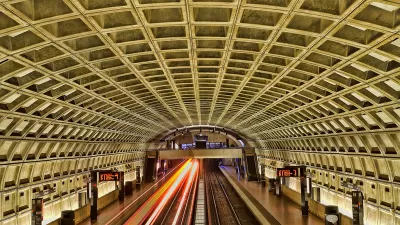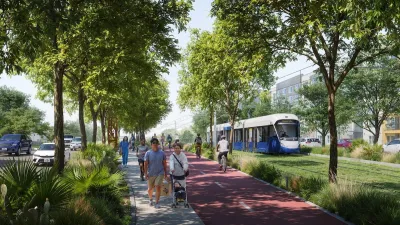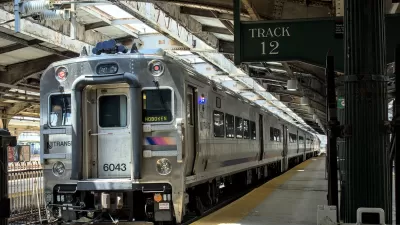Facing a $750 million ‘fiscal cliff,’ the agency says it’s important to continue looking forward to ‘visionary’ future plans.

The Washington Metropolitan Area Transit Authority (Metro) announced ambitious goals to add new buses or even a rail line to its system to ease pressure on capacity in the Rosslyn Tunnel, writes Jordan Pascale in DCist.
“But what about Metro’s $750 million fiscal cliff we’ve heard about in recent weeks?” Pascale asks. “WMATA officials who briefed the media on Monday acknowledged it is challenging to talk about the near-term fiscal cliff and structural operating deficit and these larger regional plans, but they say it is important for the region to continue planning for these larger visionary plans even while working through short and medium-term structural issues.”
Providing background on “the Rosslyn problem,” Pascale explains, “The Rosslyn tunnel serves the Orange, Blue, and Silver lines and can carry 26 trains per hour. Metro used to run rush hour service that was limited by that capacity, but Metro is now scheduling 16 trains an hour through the tunnel and soon hopes to run 20 trains per hour in the coming months.”
According to Metro, “new lines could improve equity transit accessibility in lower-income areas, and improve sustainability by getting more people on transit.” Pascale details the options Metro is considering, which include building a new tunnel under the Potomac and separating the Silver or Blue lines, as well as lower-cost alternatives that would add more buses or Bus Rapid Transit (BRT) routes. See the source article for more information on each proposal.
FULL STORY: Will Metro Go Ahead With Its Biggest Rail Expansion Since The Silver Line?

Study: Maui’s Plan to Convert Vacation Rentals to Long-Term Housing Could Cause Nearly $1 Billion Economic Loss
The plan would reduce visitor accommodation by 25,% resulting in 1,900 jobs lost.

North Texas Transit Leaders Tout Benefits of TOD for Growing Region
At a summit focused on transit-oriented development, policymakers discussed how North Texas’ expanded light rail system can serve as a tool for economic growth.

Why Should We Subsidize Public Transportation?
Many public transit agencies face financial stress due to rising costs, declining fare revenue, and declining subsidies. Transit advocates must provide a strong business case for increasing public transit funding.

How to Make US Trains Faster
Changes to boarding platforms and a switch to electric trains could improve U.S. passenger rail service without the added cost of high-speed rail.

Columbia’s Revitalized ‘Loop’ Is a Hub for Local Entrepreneurs
A focus on small businesses is helping a commercial corridor in Columbia, Missouri thrive.

Invasive Insect Threatens Minnesota’s Ash Forests
The Emerald Ash Borer is a rapidly spreading invasive pest threatening Minnesota’s ash trees, and homeowners are encouraged to plant diverse replacement species, avoid moving ash firewood, and monitor for signs of infestation.
Urban Design for Planners 1: Software Tools
This six-course series explores essential urban design concepts using open source software and equips planners with the tools they need to participate fully in the urban design process.
Planning for Universal Design
Learn the tools for implementing Universal Design in planning regulations.
Ascent Environmental
Borough of Carlisle
Institute for Housing and Urban Development Studies (IHS)
City of Grandview
Harvard GSD Executive Education
Toledo-Lucas County Plan Commissions
Salt Lake City
NYU Wagner Graduate School of Public Service





























